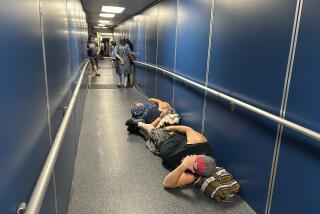Do It Right This Time, FAA
Two issues arise now that the Federal Aviation Administration has awarded a $950-million contract for installing new air traffic control radar systems and other control tower electronics between 1998 and 2007. The first is the pressing need to have this program up and running on schedule, if not sooner. The second is simply this: Has the FAA finally gotten it right?
Air travelers and those who wait for them on the ground best know the flaws of the 1950s- and 1960s-era technology that continues to direct so much of the nation’s burgeoning traffic through the skies. The examples of delays and potential disasters, even with newer equipment, are disturbing to say the least.
March 1996: Two jumbo jets that approached Los Angeles International Airport on a collision course came within two miles of each other after air traffic control radios failed. Controllers say that aircraft, at least once a day somewhere in the United States, fly closer to each other than permitted under FAA rules.
July 1996: A mysterious problem with FAA traffic radar in Palmdale stalled the arrival and departure of more than 100 flights at LAX. It also caused hundreds of delays at airports in Las Vegas, Ontario and San Diego.
By one account, more than 1,200 flights have been delayed in the last 16 months because of computer failures at regional air traffic control centers.
In 1995, there were at least 11 air traffic control equipment failures or complete shutdowns. A breakdown at the Chicago air traffic control center, the nation’s busiest, lasted 24 hours.
Should we wonder whether the FAA is on track now? Sure. The FAA has struggled through several modernization programs that have bogged down and eventually have been scrapped--to the tune of wasted millions of dollars--in recent decades. That cannot be allowed to occur again, not with the growing pressures placed on the system by increased traffic.
Overseeing the new effort will be the top priority for whoever is tapped to replace outgoing FAA Administrator David Hinson. The new administrator will be looking at a full revamp. Raytheon beat out Lockheed Martin and Boeing for the contract to provide new control systems to several hundred civilian and military airfields around the country. Hughes Information Systems and Sun Microsystems, both of California, are among the subcontractors.
And, this time, the deal calls for the contractor to use commercial, off-the-shelf equipment that has already been tested and marketed internationally. Raytheon’s system, for example, is in use in Canada, Germany, India and other nations.
The goal goes far beyond keeping up with today’s air traffic. LAX, which already handles an average of 2,000 takeoffs and landings each day, can expect a 23% increase in that figure within the next 14 years. All the more reason to make certain that there is effective modernization of the equipment intended to keep our skies safe.
More to Read
Inside the business of entertainment
The Wide Shot brings you news, analysis and insights on everything from streaming wars to production — and what it all means for the future.
You may occasionally receive promotional content from the Los Angeles Times.










